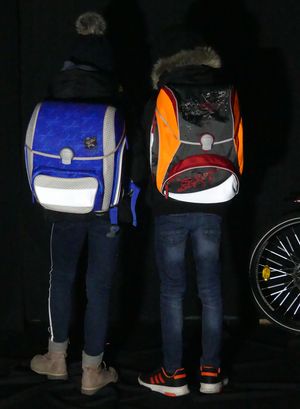KANBrief 1/19

Every year, over 700,000 children in Germany start school. When choosing a satchel, these 5 to 6-year-olds are motivated primarily by its colour and graphics. Parents should however ensure that the satchel is easily visible and complies with the DIN standard. This substantially enhances the safety of their children on the journey to and from school.
DIN 58124, Satchels – Requirements and testing, describes the properties that a satchel must possess in order to be considered easily visible, ergonomic and functional. Many satchels on sale fail to satisfy the requirements of the standard, however. In particular, they lack the fluorescent areas that are important for visibility. The argument is that the orange/red and yellow colours familiar from high-visibility vests for drivers are difficult to reconcile with a "cool" design. During revision of the standard, solutions were therefore sought by which the requirements upon both design and visibility could be met. The new edition of the standard published in October 2018 now permits further fluorescent colours such as yellow/green and pink. This provides the manufacturer with more options for design of the satchel. Manufacturers, suppliers, universities, the DIN Consumer Council and TÜV were represented on the standards committee. Since safety on the journey to school is an important issue for the German Social Accident Insurance, the Schools Sub-committee of the DGUV, the Institute for Occupational Safety and Health of the DGUV (IFA) and the KAN Secretariat were also involved.
Reflective areas on their child's new satchel give many parents a false sense of security. These areas are essential in darkness, and where lighting is poor are often the only thing on the child that a car driver sees. The DIN standard requires these reflective materials to account for at least 10% of the rear and side areas of the satchel. Recent field tests conducted by the IFA show that even the small reflectors that are required by the standard on the straps of the satchel considerably improve visibility from the front. They must however not be obscured by scarves or other items of clothing, or slip too far up on a poorly fitting satchel tipping to the rear.
At the same time, it is often not adequately appreciated that fluorescent surfaces on the satchel are equally important in order for the child to be visible to traffic. The standard requires fluorescent surfaces to account for at least 20% of the rear and side areas of the satchel. These surfaces amplify the ambient light and emit light even when the residual light is low; they are consequently conspicuous during the day and at dusk. Viewed over the year, these are precisely the times of day at which primary school children are most frequently travelling.
Consumer bodies and the German Social Accident Insurance have joined in calling for public information on what aspects should be considered during the selection and use of a satchel. For example, a working group comprising delegates from the German Social Accident Insurance Institutions for the public sector and KAN is producing a leaflet that is to be distributed through kindergartens to parents of pre-school children. Besides visibility, the leaflet also addresses ergonomic and functional aspects. Some progress has been made regarding the ergonomic design of satchels. Well-padded shoulder straps, back elements with geometry adapted to the child's body and adjustable as the child grows, and chest and hip straps assist in distributing the weight effectively. It is important for the child to try on the satchel and for parents to be advised competently to ensure that it is suitable for the child and is properly adjusted.
Parents can obtain information before purchasing by reading test reports from consumer organizations. When purchasing a satchel they should check that a statement of compliance with DIN 58214 appears on the satchel itself or in the user instructions. A GS mark demonstrates that an officially recognized body has checked the satchel's compliance with the safety requirements of the standard.
Other means exist of increasing schoolchildren's visibility, such as high-visibility vests. These are however partly obscured by the satchel. The initial motivation to wear a high-visibility vest also often decreases in the spring and summer. By contrast, the child always has a satchel with them. Visibility, even during the day, is built in when a satchel meets the requirements of the standard. Children's safety therefore begins with the choice of satchel.
Werner Sterk
sterk@kan.de